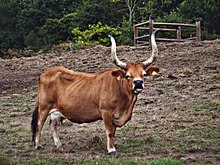Cachena beef

The Cachena beef is a breed of cattle from the north of Portugal and Galicia . It is a kind of miniature barrosa that only occurs in very small populations.
Origin and appearance
Cachena cattle are one of the smallest cattle breeds in the world: the height at the withers of the cows is only 110 to 117 cm on average at 390 kg. The bulls measure 120 to 125 cm at 550 kg. The coat color is pale brown, blond to intensely reddish with dark brown nuances in the shoulder area. The mucous membranes are unpigmented with the exception of the dark muzzle . The huge, sweeping, lyre-shaped curved horns up to 75 cm long, which make them appear larger, are particularly characteristic .
The origin of the Barrosa and thus also the Cachena is unknown. The Cachena represent the Barrosa in reduced form in all parts. There are different theories of ancestry. Characteristics of ancestry with the " bos taurus desertorum " are only based on the shape of their horns and therefore represent a too weak hypothesis. French 1969 suspects a palaeontological relationship and similarity with the " bos primigenius mauretanicus ", from which some cattle breeds in North Africa are also derived to let.
The well-known Spanish cattle scientist Antonio Sánchez Belda wrote about the appearance in 1967 on the occasion of a cattle colloquium in Portugal: "The aesthetics and especially the expression of the head and the delicate harmony within its small body give the specimens of this breed a unique character that cannot be compared to any other Race in Europe. " Sánchez Belda attributes an independent development to the breed. He names his own branch of descent, the so-called " tronco cantabrio ", and thus brings the Cachena close to a relic. The breed must have existed in the north of Portugal since unthinkable times, with interbreeding and new breed formation, such as the Portuguese breeds Arouquesa , Maronesa , Mirandesa .
distribution
Cachena cattle originally come from the Vila Real district , from the Barroso mountainous landscape, or Alturas do Barroso ( Montalegre and Boticas ), an agriculturally poor region in the far north of Portugal . The climate is hot and dry in summer, cold and humid in winter. The soils are steep, stony and not very fertile. Cachena cattle spread across the mittelgebirgigen districts of municipalities that are part of the Spanish natural park Baixa Limia-Serra do Xurés are on the frontier with Portugal, especially around the ourensische village Olelas , they also come in the mountain regions of the Portuguese National Park Peneda-Gerês ago .
use
Originally, as a typical landrace, the Cachena cattle were three-purpose cattle: milk, meat and work. Today they are used more for meat production. It is known for its good quality. The Cachena cow produces a small amount of milk, but it has a very good taste, perfumed by the wild surroundings and refined by the production of the cheese "Brandas da cachena". The meat is a Portuguese DOC product and is marketed under the name "Carne Cachena da Peneda".
It is a very rustic breed that is well adapted to its environment. Cachenas are kept outdoors all year round. With their extremely fine sense of smell, they look for rare herbs in the branches. The cows are very good mothers and look after their calves in an exemplary manner. In their environment, they defend themselves and their calves from the Iberian wolves by forming a protective wall with their heads and horns. The small size seems to be an adaptation to the hostile environment. A small cow needs less energy and is better able to survive periods of hunger.
protection
The population of Cachena cattle in Spain in 1991 was 220 cows and 22 bulls in 18 herds.
In Portugal, a plan for the conservation of endangered species of domestic animals has been launched. A herd book was established in 1990.
literature
- Antonio Sánchez Belda: Razas Bovinas Españolas. Ministerio de Agricultura, Pesca y Alimentación, Madrid 1984, ISBN 84-341-0371-0 .
- Andreas Schumann: The Cachena beef - a forgotten gem from the mountainous region of Galicia. (PDF file; 205 kB) In: Arche Nova. Issue 3, September 17, 2002, ZDB -ID 286062-4 , pp. 10-11.
Individual evidence
- ↑ Photograph with a person for size comparison ( memento of the original from May 6, 2009 in the Internet Archive ) Info: The archive link was inserted automatically and has not yet been checked. Please check the original and archive link according to the instructions and then remove this notice.
- ^ Antonio Sánchez Belda: Razas Bovinas Españolas. 1984.
- ↑ Andreas Schumann: The Cachena cattle - a forgotten gem from the mountainous region of Galicia. In: Ark Nova. Issue 3, September 17, 2002, p. 11.
Web links
- (gl) Boaga
- (es) federapes
- (it) cachena
- (pt) barrosa et cachena
- (pt) Programa Terra sobre a Raça Cachena ; Porto Canal TV report on Youtube

